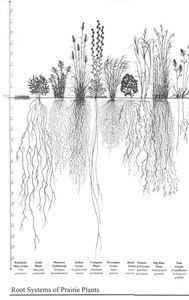Root System
Types Of Roots, Importance Of Roots

In most plants, the root system is a below-ground structure that serves primarily to anchor the plant in the soil and take up water and minerals. Roots may be less familiar than the more visible flowers, stems, and leaves, but they are no less important to the plant.
Roots have four regions: a root cap; a zone of division; a zone of elongation; and a zone of maturation. The root cap is a cup-shaped group of cells at the tip of the root which protects the delicate cells behind the cap as it pushes through the soil. The root cap secretes mucigel, a substance that acts as a lubricant to aid in its movement. The root cap also plays a role in a plant's response to gravity. If a flower pot is placed on its side, the stem would grow upward toward the light, and the root cap would direct the roots to grow downward. Above the root cap is the zone of division, and above that is the zone of elongation. The zone of division contains growing and dividing meristematic cells. After each cell division, one daughter cell retains the properties of the meristem cell, while the other daughter cell (in the zone of elongation) elongates sometimes up to as much as 150 times. As a result, the root tip is literally pushed through the soil.
In the zone of maturation, cells differentiate and serve such functions as protection, storage, and conductance. Seen in cross section, the zone of maturation of many roots has an outer layer (the epidermis), a deeper level (the cortex), and a central region that includes the conducting vascular tissue.
Figure 1. Early stages in the development of a root tip, illustrating its four regions.
Figure 2. The root cap shown in relation to root hairs and emerging lateral roots.
The epidermis is usually a single layer of cells at the outer edge of the root, which absorbs water and dissolved minerals, a function greatly facilitated by the presence of root hairs. Root hairs form from the outward growth of epidermal cells and are restricted to a small area near the root tip. A single four-month-old rye plant was estimated to have approximately 14 billion root hairs.
The cortex occupies most of the volume of young roots, and is important for storing substances such as starch.
At the root's center is the region of vascular tissue which functions in the transport of water up the root and into the stem (in xylem tissue), and in the transport of carbohydrates and other substances from the stem down into the root (in phloem tissue). Cells in the xylem and phloem either attach to each other end-toend or are tapered, with overlapping walls, facilitating the movement of substances from cell to cell. In many plants, a single cluster of xylem and phloem cells occupies a relatively small area of the root cross section. In other plants, a cylinder of vascular tissue forms a ring around a center of relatively undifferentiated cells, called the pith.
Roots often form symbiotic associations with soil fungi called mycorrhizae. In this association, the plant benefits from phosphorus that is taken up and supplied by the fungus, and the fungus benefits from carbohydrates produced by the plant. Plants grown in the absence of soil mycorrhizae generally do less well than when mycorrhizae are present.
Another symbiotic root association is between plants such as peas and beans (family Leguminosae) and Rhizobium bacteria. The bacteria penetrate the root cells, multiply, and in doing so form nodules where the bacteria have access to carbohydrates synthesized by the plant. In return, the bacteria "fix" nitrogen, converting nitrogen gas from the atmosphere into nitrogen-containing compounds that can be used by plants.
Additional topics
Science EncyclopediaScience & Philosophy: Revaluation of values: to Sarin Gas - History And Global Production Of Sarin